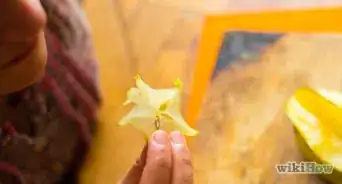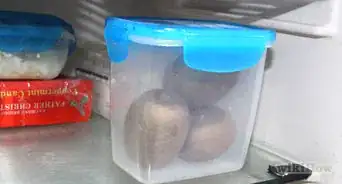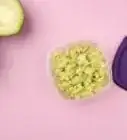This article was co-authored by wikiHow Staff. Our trained team of editors and researchers validate articles for accuracy and comprehensiveness. wikiHow's Content Management Team carefully monitors the work from our editorial staff to ensure that each article is backed by trusted research and meets our high quality standards.
There are 7 references cited in this article, which can be found at the bottom of the page.
The wikiHow Video Team also followed the article's instructions and verified that they work.
This article has been viewed 12,420 times.
Learn more...
Fennel, a bulbous vegetable with a top that looks a bit like dill, is versatile in the kitchen. The top can be used in salads and the bulb can be grilled, braised, or eaten fresh. Fennel can even be used as a celery substitute with roasted meats! However, sometimes you don’t want to use fennel immediately. Fortunately, there are several ways to store fennel and keep it tasting delicious for later.
Steps
Refrigerating Fennel
-
1Trim the fronds 2 to 3 inches (5.1 to 7.6 cm) above the bulb. Don’t wash the fennel beforehand, as washing vegetables inevitably damages them. The damaged spots will start rotting right afterwards unless you cook and use the fennel immediately.[1]
- The fronds are the feathery green parts on top of the bulb.
- If you’d like to use the stalks and bulbs for separate cooking purposes, keep them apart when storing. Otherwise, there’s no need.[2]
-
2Wrap the fennel loosely in a plastic bag. This can even be a grocery produce bag, as you do not necessarily have to seal the fennel in a Ziploc bag. However, make sure you get all the air out of the bag once you place the fennel inside.[3]Advertisement
-
3Place the fennel in the produce drawer. Remember that if the drawer is packed with other vegetables, the fennel will likely go bad faster. Therefore, try to keep the fennel at a distance from the other vegetables.[4]
- The fennel should last for 5-10 days.
-
4Put the fennel leaves in a container of cold water, not a bag, instead. Then, seal the container and refrigerate it. This way, the fennel will last for 5-6 days. You can also leave the container on the counter for a few days, though the fennel will start to lose flavor faster than in the fridge.[5]
- Fennel is mostly water, so keep it away from the coldest area of the fridge. If it freezes, it will become mushy and wilt rapidly, destroying texture and flavor.[6]
Freezing Fennel
-
1Cut or pull the herbs gently from the fennel bulb. If you’re too rough, the bulb is likely to bruise. If you plan to freeze the fennel leaves, cut those from the stalks as well. Exercise caution when using sharp knives.[7]
-
2Put a spoonful of leaves in each ice tray compartment. Then, fill each section with water and place the whole tray in the freezer. To keep the cubes fresher for longer, put them in a plastic or storage container once they’re done freezing.[8]
- Use the cubes in soups or sauces, if you’d like.
-
3Blanch the fennel bulbs. To do this, boil water in a large pot on medium-high heat. Add the fennel and boil for 2-3 minutes. Then, remove and quickly transfer the fennel to cold water. Once it has cooled, remove the fennel and place on a paper towel to dry for 1-2 minutes.[9]
- Blanching stops enzyme processes that cause loss of flavor, color and texture. It also cleans the vegetables and slows the loss of vitamins.[10]
-
4Seal the blanched bulbs in a storage container and freeze. You can also use a high quality freezer bag, if you’d prefer. The bulbs will likely last for 5-6 months, but the flavor will probably be reduced the longer the fennel is frozen.[11]
- To use the fennel, simply remove the container from the freezer and thaw.
Drying Fennel
-
1Remove the seed heads from the fennel. They are oval and a light olive green. You can do this with a knife by gently cutting the seeds free. Also, you can try putting the fennels in a paper bag and shaking firmly to release the seed heads.[12]
-
2Spread the seeds on a clean surface and let dry for 2-4 days. The area should also be well-ventilated. Try not to dry them directly in the sun, as prolonged exposure to sunlight can drain away the flavor.[13]
- Alternatively, you can use an oven to dry the seeds. Put the seeds in a cooking tray and leave them there at the lowest oven temperature for about 15 minutes.[14]
-
3Air-dry the fennel leaves and branches, to use more than just the seeds. You can also dry just the leaves. To do this, cut the bulb from the fennel fronds. Then, tie the fennel leaves in a bunch with string and hang upside-down to dry in a ventilated place.[15]
- Drying the seeds is more popular because fennel leaves are more likely to lose their flavor after being dried.[16]
-
4Transfer the fennel to an airtight container and store. This will work whether you dried the entire fennel or only the fennel seeds. Cabinets, drawers, or even the freezer can be appropriate storage locations as long as the area is cool, dry, and away from direct sunlight.[17]
References
- ↑ https://www.gettystewart.com/fennel-what-is-it-and-how-do-i-select-store-and-use-it/
- ↑ https://www.homestratosphere.com/how-to-store-fennel
- ↑ https://www.homestratosphere.com/how-to-store-fennel/
- ↑ https://www.homestratosphere.com/how-to-store-fennel/
- ↑ https://www.homestratosphere.com/how-to-store-fennel/
- ↑ https://www.youtube.com/watch?v=9WNa_O6dpAA&feature=youtu.be&t=68
- ↑ https://www.homestratosphere.com/how-to-store-fennel/
- ↑ https://www.homestratosphere.com/how-to-store-fennel/
- ↑ https://www.homestratosphere.com/how-to-store-fennel/
- ↑ https://nchfp.uga.edu/how/freeze/blanching.html
- ↑ https://www.herbatorium.com/470/storing-fennel-in-the-right-manner/
- ↑ https://www.homestratosphere.com/how-to-store-fennel/
- ↑ https://www.herbatorium.com/470/storing-fennel-in-the-right-manner/
- ↑ https://gordanladdskitchen.com/knowledge/how-to/best-ways-storing-fennel/
- ↑ https://gordanladdskitchen.com/knowledge/how-to/best-ways-storing-fennel/
- ↑ https://www.herbatorium.com/470/storing-fennel-in-the-right-manner/
- ↑ https://www.homestratosphere.com/how-to-store-fennel/






















































